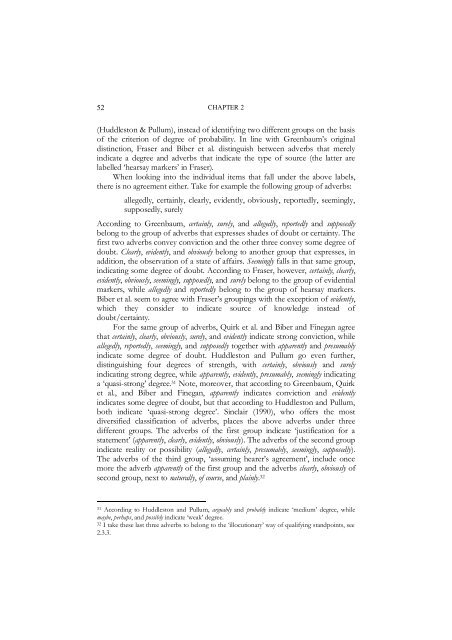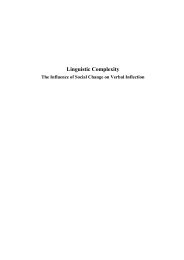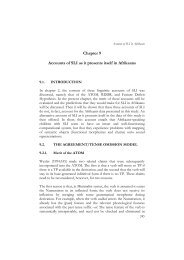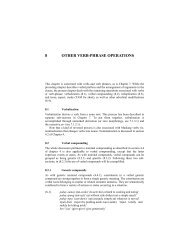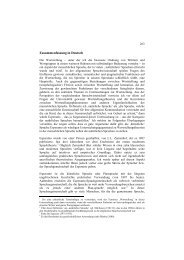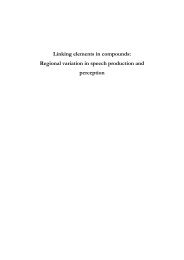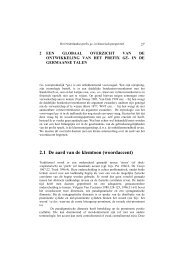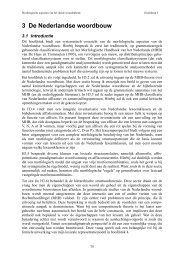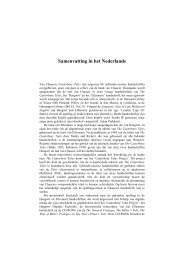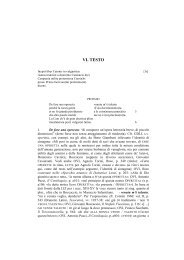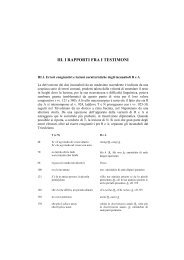chapter 2 stance adverbs qualifying a standpoint - LOT publications
chapter 2 stance adverbs qualifying a standpoint - LOT publications
chapter 2 stance adverbs qualifying a standpoint - LOT publications
You also want an ePaper? Increase the reach of your titles
YUMPU automatically turns print PDFs into web optimized ePapers that Google loves.
52<br />
CHAPTER 2<br />
(Huddleston & Pullum), instead of identifying two different groups on the basis<br />
of the criterion of degree of probability. In line with Greenbaum‟s original<br />
distinction, Fraser and Biber et al. distinguish between <strong>adverbs</strong> that merely<br />
indicate a degree and <strong>adverbs</strong> that indicate the type of source (the latter are<br />
labelled „hearsay markers‟ in Fraser).<br />
When looking into the individual items that fall under the above labels,<br />
there is no agreement either. Take for example the following group of <strong>adverbs</strong>:<br />
allegedly, certainly, clearly, evidently, obviously, reportedly, seemingly,<br />
supposedly, surely<br />
According to Greenbaum, certainly, surely, and allegedly, reportedly and supposedly<br />
belong to the group of <strong>adverbs</strong> that expresses shades of doubt or certainty. The<br />
first two <strong>adverbs</strong> convey conviction and the other three convey some degree of<br />
doubt. Clearly, evidently, and obviously belong to another group that expresses, in<br />
addition, the observation of a state of affairs. Seemingly falls in that same group,<br />
indicating some degree of doubt. According to Fraser, however, certainly, clearly,<br />
evidently, obviously, seemingly, supposedly, and surely belong to the group of evidential<br />
markers, while allegedly and reportedly belong to the group of hearsay markers.<br />
Biber et al. seem to agree with Fraser‟s groupings with the exception of evidently,<br />
which they consider to indicate source of knowledge instead of<br />
doubt/certainty.<br />
For the same group of <strong>adverbs</strong>, Quirk et al. and Biber and Finegan agree<br />
that certainly, clearly, obviously, surely, and evidently indicate strong conviction, while<br />
allegedly, reportedly, seemingly, and supposedly together with apparently and presumably<br />
indicate some degree of doubt. Huddleston and Pullum go even further,<br />
distinguishing four degrees of strength, with certainly, obviously and surely<br />
indicating strong degree, while apparently, evidently, presumably, seemingly indicating<br />
a „quasi-strong‟ degree. 31 Note, moreover, that according to Greenbaum, Quirk<br />
et al., and Biber and Finegan, apparently indicates conviction and evidently<br />
indicates some degree of doubt, but that according to Huddleston and Pullum,<br />
both indicate „quasi-strong degree‟. Sinclair (1990), who offers the most<br />
diversified classification of <strong>adverbs</strong>, places the above <strong>adverbs</strong> under three<br />
different groups. The <strong>adverbs</strong> of the first group indicate „justification for a<br />
statement‟ (apparently, clearly, evidently, obviously). The <strong>adverbs</strong> of the second group<br />
indicate reality or possibility (allegedly, certainly, presumably, seemingly, supposedly).<br />
The <strong>adverbs</strong> of the third group, „assuming hearer‟s agreement‟, include once<br />
more the adverb apparently of the first group and the <strong>adverbs</strong> clearly, obviously of<br />
second group, next to naturally, of course, and plainly. 32<br />
31 According to Huddleston and Pullum, arguably and probably indicate „medium‟ degree, while<br />
maybe, perhaps, and possibly indicate „weak‟ degree.<br />
32 I take these last three <strong>adverbs</strong> to belong to the „illocutionary‟ way of <strong>qualifying</strong> <strong>standpoint</strong>s, see<br />
2.3.3.


